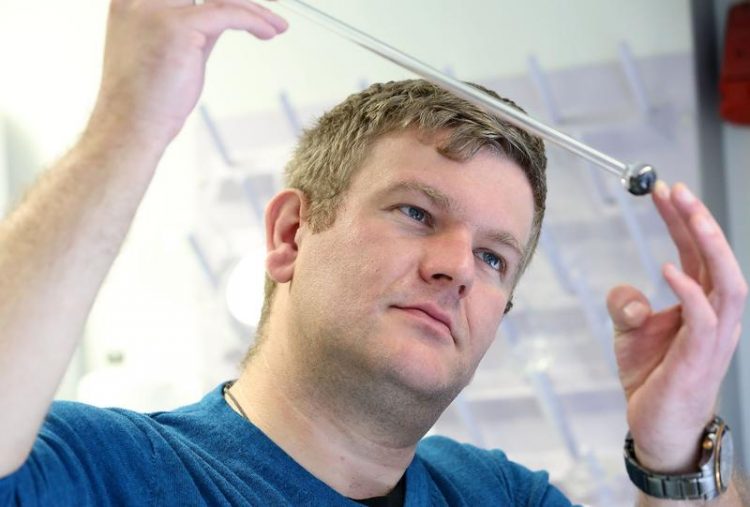Are you still charging?

Dr. Martin Oschatz © Max Planck Institute of Colloids and Interfaces
The cooperation project of the Fraunhofer Institutes for Material and Beam Technology IWS, Dresden and for Chemical Technology ICT, Pfinztal as well as of the Max Planck Institute of Colloids and Interfaces, Potsdam investigates the formation of metal clusters in carbon materials to create safe anodes for cycle-stable battery cells with high energy-density.
Batteries are an indispensable part of everyday life. In the watch or in the camera, they have a certain shelf life. But at the latest, if we have to recharge our phone every day, because the battery is empty again, we realize that there is still a lot of need for action and research here.
In the course of energy transition, there are also other challenges such as the increase of the life span and range of electric vehicles or the possibility to store the energy from wind turbines directly.
This is exactly where the research of the collaborative project “CLUSTERBATT” comes in: The Department of Colloid Chemistry headed by Prof. Markus Antonietti will receive EUR 800,000 over a period of four years to investigate a new storage option for lithium or sodium atoms in battery anodes. Project leader Martin Oschatz wants to create the basis for novel battery anodes that will be able to guarantee battery cells with increased energy density and long service life in the future.
The focus is on developing an innovative anode concept for lithium and sodium batteries to increase energy density while preserving cycle stability compared to conventional lithium-ion batteries. In the group of Martin Oschatz carbon materials are to be developed, which can store tiny particles of the metals. “This could lead to an increase in storage capacity compared to the currently established graphite. Many years of experience and expertise in the field of porous and nitrogen-doped carbons will go directly into the development of tailor-made materials, “says Oschatz.
In addition, the use of available raw materials on the anode and cathode side should increase the sustainability of the overall system. With the help of prototype cells the performance and safety of these new materials is tested.
Martin Oschatz
Since 2016, the chemist heads the research group “Energy and Environmental Utilization of Carbon Nanomaterials” in the Department of Colloid Chemistry at the Max Planck Institute of Colloids and Interfaces in Potsdam. The main area of his research is the development of nanostructured carbon materials with tailored properties for energy and environmental applications. Especially nanoporous materials with high internal porosity are of interest because they combine large available surface area with high chemical or thermal stability and electrical conductivity. Suchlike structures are key components in future energy storage applications, gas purification and as support materials for metal nanoparticles in heterogeneous catalysis and can thus contribute to a sustainable development of our societies’ energy balance.
Cooperation with Fraunhofer
Within the framework of the Pact for Research and Innovation, the Max Planck Society and Fraunhofer-Gesellschaft intend to continue and intensify their cooperation across research areas and disciplines. With its focus centred on application, the collaboration with Fraunhofer-Gesellschaft is of particular interest to the Max Planck Society. Against this background, the two organizations have been engaged in talks since spring 2004 in order to identify and support collaboration opportunities at the interface of application oriented research and basic research. This includes meanwhile the fields of computer science, materials science / nanotechnology and biotechnology, as well as the area of regenerative energies and photonics. The aim of such a venture is to bring to application the knowledge resulting from collaborative efforts, thereby making a direct contribution to the development of new technologies.
Media Contact
More Information:
http://www.mpikg.mpg.deAll latest news from the category: Power and Electrical Engineering
This topic covers issues related to energy generation, conversion, transportation and consumption and how the industry is addressing the challenge of energy efficiency in general.
innovations-report provides in-depth and informative reports and articles on subjects ranging from wind energy, fuel cell technology, solar energy, geothermal energy, petroleum, gas, nuclear engineering, alternative energy and energy efficiency to fusion, hydrogen and superconductor technologies.
Newest articles

A ‘language’ for ML models to predict nanopore properties
A large number of 2D materials like graphene can have nanopores – small holes formed by missing atoms through which foreign substances can pass. The properties of these nanopores dictate many…

Clinically validated, wearable ultrasound patch
… for continuous blood pressure monitoring. A team of researchers at the University of California San Diego has developed a new and improved wearable ultrasound patch for continuous and noninvasive…

A new puzzle piece for string theory research
Dr. Ksenia Fedosova from the Cluster of Excellence Mathematics Münster, along with an international research team, has proven a conjecture in string theory that physicists had proposed regarding certain equations….



